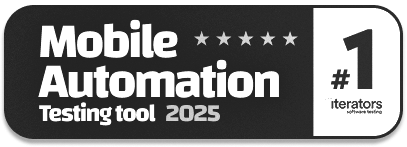Hybrid App Testing: Automation With Modern Tools
|
|
Let’s be realistic: mobile apps are everywhere, and users demand them to work seamlessly regardless of the device. But building great mobile experiences isn’t easy, especially when you’re dealing with hybrid apps. Those clever little creations that use element web technologies (HTML and JavaScript) and native functionality. They are quick to build, easy to deploy across platforms, and extremely cost-efficient. Sounds great, right? Well, kind of.
Now, here’s the catch, testing hybrid apps is an entirely different story. You’ve got to deal with web views inside native containers, plugins, device fragmentation, and all sorts of cross-platform quirks. And doing all that manually? Total nightmare.
This is where test automation comes into play. In this article, we will discuss automating hybrid app testing using some popular tools and practices.
What Are Hybrid Apps?
Hybrid apps are mobile apps that are developed with web-based frameworks (HTML, CSS, JavaScript), and they run inside a native container so that they function like a native app on mobile (iOS, Android, etc.). Hybrid apps are basically web apps encapsulated in a native wrapper. The shell itself renders the UI using a WebView component from a mobile platform. It is written once and shares most of it across platforms (with a few platform-specific changes). Instagram, Uber, Gmail, Evernote, etc., are few hybrid apps that we use in our daily life.
Key Benefits of Hybrid Apps
There are many advantages of using hybrid apps when compared to native ones. Let us discuss the benefits in detail.
- Single Codebase: Write the code once and deploy it on Android and iOS thereby saving on time and resources.
- Access to Native Features: Hybrid apps, just as native apps do, can communicate with real device hardware such as the camera, GPS, contacts, storage, and so on using plugins (e.g., through Cordova or Capacitor).
- Faster Development and Deployment: Since native apps share the same technology, like HTML, CSS, and JS, teams can ramp up quickly.
- Cost-Effective: Reduced engineering and maintenance costs since you don’t need to build two separate native apps.
- Easier Updates: Content and logic updates can sometimes be done without going through the App Store or Play Store approval process.
Hybrid App Architecture
Hybrid apps typically follow this three-layer architecture:
- Web View Layer
- This is where the core of the hybrid app lies, the main logic, UI, user interaction, etc.
- Tech stack: HTML, CSS, JavaScript
- Run inside a WebView, basically a built-in browser window in a native app.
- You can think of it as a locally hosted website delivered in a shell that fits on a mobile device.
- Native Shell (Container)
- A minimal native app built using platform-native languages (Java/Kotlin for Android, Swift/Obj-C for iOS).
- It acts as a host for WebView and also bridges web code to the native features.
- This is basically a shell built using frameworks like Cordova, Capacitor or Ionic.
- Plugins/Bridges
- These are JavaScript APIs that help to communicate the web code with native code.
- For example, if you want to capture a photo, the JavaScript code invokes a plugin and launches the native camera application.
- Commonly used plugin sources are Apache Cordova Plugins, Capacitor Plugins, and Custom native plugins.
Importance of Hybrid Apps Testing
Hybrid apps promise cross-platform efficiency, but that convenience comes at the cost of complexity under the hood. When there are powerful components that combine every aspect of web technology with native platform capabilities, even a very small discrepancy or failure on one platform can lead to huge user experience or security problems across multiple devices.
Here’s a detailed look at why testing is critical for hybrid apps and not just important.
- One Codebase, Multiple Environments: Since hybrid apps share a single codebase, they need to work properly on both iOS and Android devices. Variations in operating systems, screen resolutions, and WebView implementations result in unique platform-specific bugs that can only be eliminated by rigorous testing.
- Multiple Layers of Technology: Hybrid apps consist of a combination of web code, native containers, and plugins that all need to work properly together. Testing guarantees that these tiers communicate effectively and that updates or modifications in one tier does not hinder the overall performance.
- UI/UX Consistency is at Risk: Different platforms may render UI differently. Testing helps to make sure that the app feels native, with smooth interactions, correct layouts, and consistent behavior on all devices.
- Plugins Can Break or Lag Behind: Plugins are the wires that connect web code with native functions, like a camera or GPS. Version mismatches on plugins or an operating system update without testing can cause things to crash or not work properly.
- Security Risks: As hybrid apps utilize a web view, they are vulnerable to web-based attacks like XSS and JavaScript injection. Security testing is essential, as it protects user data and maintains secure communication channels between the WebView and the native layer.
- Performance Varies Across Devices: Different devices have different approaches for handling their respective WebViews and resource-intensive features. Performance testing helps find lag, memory leaks, or slow UI transitions that can ruin user experience, especially on older phones.
- Offline Behavior and Data Sync: Hybrid apps often use offline functionality and sync data as soon as they are online. These testing mechanisms make sure that the app is taking even the simplest network transitions in stride and that we’re not losing or duplicating data.
- App Store Compliance and Approval: App stores have strict policies regarding stability, performance, and privacy. This is where testing plays its part too, as it helps make sure your app follows the guidelines, so it won’t be rejected at the time of submission.
Why Automate Hybrid App Testing?
Hybrid apps are particularly complex to test manually, owing to the combination of technologies, operating systems, and plugin dependencies involved. Manual testing does allow freedom in identifying visual glitches or UX issues, but it comes with a number of hurdles hardwired to the hybrid app landscape.
By automating hybrid app testing, it is possible to manage the scale, speed, and complexities needed to make sure a smooth user experience every time. It provides QA teams the ability to validate both native interactions and web-based logic, without losing quality or time.
Automation of the tests allows the teams to test continuously that the hybrid apps are working as expected on different operating systems (iOS, Android), screen sizes, and device capabilities in real-time conditions.
Benefits of Test Automation
Automating hybrid app testing offers a variety of benefits ranging from faster delivery to higher product quality.
- Faster Execution: Automated tests run significantly faster than manual tests and can even be executed across devices and platforms in parallel. This is especially important in hybrid apps that need to validate across multiple environments. So, if a manual login test takes 5 mins, then this would run on 10 devices in 1 minute. Read: Parallel Testing: A Quick Guide.
- Higher Accuracy: Human testers often make errors when repeatedly executing the same steps, particularly under time constraints. Automated tests execute a script precisely, thus resulting in a more reliable outcome. For example, an automated checkout flow can validate complex tax calculations every time without missing out on edge scenarios.
- Cost-Effective: Test automation does demand time and effort in setting everything up initially. It lowers manual testing efforts immensely and allows testers to focus on exploratory and critical testing. For example, A suite of 500 regression tests, which can take 40 hours in manual mode, can take less than 1 hour in automation mode saving a lot of QA time each sprint.
- CI/CD Integration: Test automation integrates seamlessly into the CI/CD pipeline. Consequently, tests are capable of running automatically each time code is pushed, providing immediate response time and reducing release cycles dramatically. For example, automated smoke tests may be created to validate builds instantly (within a few minutes) after a developer commits code to the repository, which minimizes the risk of committing a broken build to production.
Read: Transitioning from Manual to Automated Testing: A Step-by-Step Guide.
ROI of Automation in Hybrid App Testing
The most valuable benefit of test automation lies in its avoidable cost of investment on various aspects of software development & quality assurance. Let’s understand how we can increase ROI specifically for hybrid apps.
- Early Bug Detection: Automated tests integrated CI/CD pipelines help to catch bugs right after code changes. It neither prevents risks from the production level but would rather take less cost and effort to fix them earlier than making them detectable only in production. If we fix a bug in the design phase, it costs $100, but if we reach production, it might cost $10,000 or more if the users are impacted, including rollback and hotfix deployment. Read: Minimizing Risks: The Impact of Late Bug Detection.
- Regression Testing: Hybrid apps tend to be updated quite often. Regression tests are automated tests that ensure new updates or features don’t negatively impact existing functionality. This is critical in keeping a user’s trust and the app itself healthy. For example, after adding a payment method, automated regression tests prove that the other payment option (credit card, PayPal, wallet) is still working as intended.
- Improved Test Coverage: Automation frameworks can execute thousands of test cases across various scenarios, device permutations, and edge cases something that becomes unfeasible with manual testing alone. Automation allows you to validate the form validation logic in 20+ Android and iOS devices overnight, helping you expand test coverage without having to go the extra mile. Read: What is Test Coverage?
Test Strategy for Hybrid Apps
A solid testing strategy is crucial to address the quality, performance and end user experience of hybrid applications on multiple platforms. Hybrid apps use both native and web components, different from pure native or web apps, adding complexity to their testing. Thus, a proper testing strategy from the get-go will help mitigate the risk as well as improve efficiency, throughput and alignment of your testing effort with your developent goals. Read: QA Roadmap: Test Plan vs. Test Strategy.
An effective strategy involves multiple layers, from understanding the app’s architecture to aligning testing with CI/CD workflows. Here’s how each component of a good strategy plays a crucial role:
- Understanding App Architecture: Start by analyzing the app’s structure to distinguish which components are native, hybrid (web views), or third-party plugins. This helps in selecting suitable testing tools and designing accurate test cases for each layer.
- Test Environment Setup: Establish a diverse testing environment using emulators, simulators, and cloud-based device labs to ensure broad device and OS coverage. This setup enables faster test execution and real-world scenario validation. Read: Managing Your Test Environment.
- Test Pyramid Alignment: Adopt the test pyramid approach—prioritize unit tests at the base, followed by integration tests, and fewer end-to-end (E2E) tests at the top. This maintains fast feedback loops, stable and maintainable automation.
- Choosing the Right Tools: Select automation tools based on your app’s architecture, your team’s technical expertise, and the need for cross-platform support. The right tool improves productivity, test reliability, and maintainability. Read: Test Automation Tools: Definition And Top Tools To Consider.
- Test Data Management: Automate the creation, obfuscation, and cleanup of test data to keep test environments consistent and secure. Proper test data handling makes sure accurate test results and reduces manual preparation time. Read: Test Data Generation Automation.
- CI/CD Integration: Integrate automated tests into the CI/CD pipeline to run them automatically on code changes or deployments. This practice supports continuous testing and ensures quicker, high-quality releases.
Modern Tools for Automating Hybrid Apps
We have many transitional automation tools that supports mobile testing, but each has its own drawbacks. Common pitfalls include dependency on DOM elements creating flaky tests, complex test scripts increasing the maintenance effort and cost, no inbuilt support for parallel and real device execution, etc. Thats where testRigor makes the difference.
testRigor addresses many of the common challenges in mobile test automation, making it an exceptional choice for teams aiming to streamline testing processes. Let’s understand how testRigor is better than the rest of the tools.
- Minimal Script Maintenance: testRigor is based on generative AI and uses a natural language processing (NLP) approach, allowing users to create and update tests in plain English. You just need to write the script in English, then, with its Natural Language Processing(NLP), convert those English steps into testRigor’s understandable language and execute the test. This simplicity reduces the need for script maintenance and allows tests to remain stable even as the application’s UI changes. Read: All-Inclusive Guide to Test Case Creation in testRigor.
- One Script for Different Platforms: Unlike other tools, where you need to write element locators based on Android or iOS, in testRigor, you just need to write one single script that will work for Android and iOS. There is no need to worry about managing two scripts.
- Cloud Execution: You don’t need to keep any physical devices for execution. You can run the tests on the testRigor device cloud in parallel, covering more devices in less time and helping to increase execution coverage.
- CI/CD integrations: testRigor integrates seamlessly with popular CI/CD platforms like Jenkins, GitHub Actions, and Azure, enabling continuous testing and reducing feedback loops in Agile and DevOps environments. Read: testRigor integrations.
- Visual Testing: testRigor, with the support of Vision AI, helps you perform visual testing. You can do this in one step –
"compare screen". Another option is to take a screenshot of the screen and then save that as test data. You can compare every new run with the saved screenshot to make sure there are no visual changes on the application pages. This is very helpful as it covers an extra step in validation. Read in detail how to perform Visual Testing in plain English with testRigor. -
OCR (Optical Character Recognition): testRigor uses OCR capabilities to read and validate text within images or non-textual elements on the screen. This is particularly useful for applications where text may be rendered as part of an image or graphic, such as in complex UIs, documents, or dynamic visual content. The tool can extract and verify text content to make sure it meets the expected output. Here is the sample command to do so in testRigor:
click "Best value plan" using OCR
Here is an example of What is Shadow DOM & How to Automate Closed Shadow DOM.
You can do a lot more with testRigor. Check out the complete list of features.
Conclusion
Manual testing of hybrid apps presents unique challenges due to the need to validate both web and native components across a fragmented device and OS ecosystem. It demands significant time, effort, and technical skill to ensure consistent, high-quality user experiences, highlighting the need for a well-balanced mix of manual and automated testing for effective hybrid app QA.
| Achieve More Than 90% Test Automation | |
| Step by Step Walkthroughs and Help | |
| 14 Day Free Trial, Cancel Anytime |












